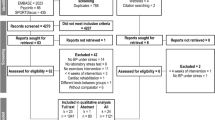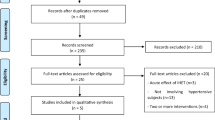Abstract
The purpose of this meta-analysis was to examine the effects of blood flow restriction training on resting blood pressure and heart rate. A meta-analysis was completed in May 2020 including all previously published papers on blood flow restriction and was analyzed using a random effects model. To be included, studies needed to implement a blood flow restriction protocol compared to the same exercise protocol without restriction. A total of four studies met the inclusion criteria for quantitative analysis including four effect sizes for resting systolic blood pressure, four effect sizes for resting diastolic blood pressure, and three effect sizes for resting heart rate. There was evidence of a difference [mean difference (95 CI)] in resting systolic blood pressure between training with and without blood flow restriction [4.2 (0.3, 8.0) mmHg, p = 0.031]. No significant differences were observed when comparing resting diastolic blood pressure [1.2 (−1, 3.5) mmHg p = 0.274] and resting heart rate [−0.2 (−4.7, 4.1) bpm, p = 0.902] between chronic exercise with and without blood flow restriction. These results indicate that training with blood flow restriction may elicit an increase in resting systolic blood pressure. However, lack of data addressing this topic makes any conclusion speculative. Based on the results of the present study along with the overall lack of long-term data, it is suggested that future research on this topic is warranted. Recommendations include making changes in resting blood pressure a primary outcome and increasing the sample size of the interventions.
This is a preview of subscription content, access via your institution
Access options
Subscribe to this journal
Receive 12 digital issues and online access to articles
$119.00 per year
only $9.92 per issue
Buy this article
- Purchase on Springer Link
- Instant access to full article PDF
Prices may be subject to local taxes which are calculated during checkout


Similar content being viewed by others
References
Mattocks KT, Jessee MB, Counts BR, Buckner SL, Grant Mouser J, Dankel SJ, et al. The effects of upper body exercise across different levels of blood flow restriction on arterial occlusion pressure and perceptual responses. Physiol Behav. 2017;15:181–6.
Renzi CP, Tanaka H, Sugawara J. Effects of Leg Blood Flow Restriction during Walking on Cardiovascular Function. Med Sci Sports Exerc. 2010;42:726–32.
Brandner CR, Kidgell DJ, Warmington SA. Unilateral bicep curl hemodynamics: low-pressure continuous vs high-pressure intermittent blood flow restriction. Scand J Med Sci Sports. 2015;25:770–7.
Mouser JG, Mattocks KT, Dankel SJ, Buckner SL, Jessee MB, Bell ZW, et al. Very-low-load resistance exercise in the upper body with and without blood flow restriction: cardiovascular outcomes. Appl Physiol Nutr Metab Physiol Appl Nutr Metab. 2019;44:288–92.
Neto GR, Sousa MSC, Costa PB, Salles BF, Novaes GS, Novaes JS. Hypotensive Effects of Resistance Exercises With Blood Flow Restriction. J Strength Cond Res. 2015;29:1064–70.
MacDougall JD, Tuxen D, Sale DG, Moroz JR, Sutton JR. Arterial blood pressure response to heavy resistance exercise. J Appl Physiol.1985 [cited 2020 May 6] https://journals.physiology.org/doi/abs/10.1152/jappl.1985.58.3.785.
Palatini P, Mos L, Munari L, Valle F, Del Torre M, Rossi A, et al. Blood pressure changes during heavy-resistance exercise. J Hypertens Suppl J Int Soc Hypertens. 1989;7:S72–73.
Sale DG, Moroz DE, McKelvie RS, MacDougall JD, McCartney N. Effect of training on the blood pressure response to weight lifting. Can J Appl Physiol Rev Can Physiol Appl. 1994;19:60–74.
Cornelissen VA, Fagard RH. Effect of resistance training on resting blood pressure: a meta-analysis of randomized controlled trials. J Hypertens. 2005;23:251–9.
Cornelissen VA, Fagard RH. Effects of Endurance Training on Blood Pressure, Blood Pressure–Regulating Mechanisms, and Cardiovascular Risk Factors. Hypertension. 2005;46:667–75.
Whelton SP, Chin A, Xin X, He J. Effect of Aerobic Exercise on Blood Pressure. Ann Intern Med. 2002;136:493–503.
Spranger MD, Krishnan AC, Levy PD, O’Leary DS, Smith SA. Blood flow restriction training and the exercise pressor reflex: a call for concern. Am J Physiol-Heart Circ Physiol. 2015;309:H1440–52.
Franklin SS, Wong ND. Hypertension and Cardiovascular Disease: contributions of the Framingham Heart Study. Glob Heart. 2013;8:49–57.
Rahimi K, Emdin CA, MacMahon S. The Epidemiology of Blood Pressure and Its Worldwide Management. Circ Res. 2015;116:925–36.
Moher D, Liberati A, Tetzlaff J, Altman DG. Preferred Reporting Items for Systematic Reviews and Meta-Analyses: the PRISMA Statement. Ann Intern Med. 2009;151:7.
Park S, Kim JK, Choi HM, Kim HG, Beekley MD, Nho H. Increase in maximal oxygen uptake following 2-week walk training with blood flow occlusion in athletes. Eur J Appl Physiol Heidelb. 2010;109:591–600.
Ozaki H, Miyachi M, Nakajima T, Abe T. Effects of 10 Weeks Walk Training With Leg Blood Flow Reduction on Carotid Arterial Compliance and Muscle Size in the Elderly Adults. Angiology. 2011;62:81–6.
Yasuda T, Fukumura K, Uchida Y, Koshi H, Iida H, Masamune K, et al. Effects of Low-Load, Elastic Band Resistance Training Combined With Blood Flow Restriction on Muscle Size and Arterial Stiffness in Older Adults. J Gerontol A Biol Sci Med Sci. 2015;70:950–8.
Ferreira Junior A, Schamne JC, Altimari LR, Okano AH, Okuno NM, Ferreira Junior A, et al. Effect of walk training combined with blood flow restriction on resting heart rate variability and resting blood pressure in middle-aged men. Mot Rev Educ Física. 2019 [cited 2020 May 26]; 25. http://www.scielo.br/scielo.php?script=sci_abstract&pid=S1980-65742019000200313&lng=en&nrm=iso&tlng=en.
Kenney MJ, Seals DR. Postexercise hypotension. Key features, mechanisms, and clinical significance. Hypertension. 1993;22:653–64.
Loenneke JP, Thiebaud RS, Abe T, Bemben MG. Blood flow restriction pressure recommendations: the hormesis hypothesis. Med Hypotheses. 2014;82:623–6.
Loenneke JP, Fahs CA, Rossow LM, Thiebaud RS, Mattocks KT, Abe T, et al. Blood flow restriction pressure recommendations: a tale of two cuffs. Front Physiol. 2013 [cited 2020 Jun 22];4. https://www.frontiersin.org/articles/10.3389/fphys.2013.00249/full.
Jessee MB, Buckner SL, Dankel SJ, Counts BR, Abe T, Loenneke JP. The Influence of Cuff Width, Sex, and Race on Arterial Occlusion: Implications for Blood Flow Restriction Research. Sports Med. 2016;46:913–21.
Mouser JG, Dankel SJ, Jessee MB, Mattocks KT, Buckner SL, Counts BR, et al. A tale of three cuffs: the hemodynamics of blood flow restriction. Eur J Appl Physiol. 2017;117:1493–9.
Spitz RW, Wong V, Bell ZW, Viana RB, Chatakondi RN, Abe T, et al. Blood Flow Restricted Exercise and Discomfort: a Review. J Strength Cond Res. 2020 [cited 2020 Oct 16]; Publish Ahead of Print. http://journals.lww.com/nsca-jscr/Abstract/9000/Blood_Flow_Restricted_Exercise_and_Discomfort__A.94519.aspx.
Acknowledgements
VW and JL contributed to the conception and design of the original work. VW, JSS, and JL worked together in the acquisition, analyzation, and interpretation of the data for the study. All authors gave the final approval of the version to be published.
Funding
There is no financial assistance received in support of the current study.
Author information
Authors and Affiliations
Corresponding author
Ethics declarations
Competing interest
The authors declare no competing interests.
Additional information
Publisher’s note Springer Nature remains neutral with regard to jurisdictional claims in published maps and institutional affiliations.
Rights and permissions
About this article
Cite this article
Wong, V., Song, J.S., Bell, Z.W. et al. Blood flow restriction training on resting blood pressure and heart rate: a meta-analysis of the available literature. J Hum Hypertens 36, 738–743 (2022). https://doi.org/10.1038/s41371-021-00561-0
Received:
Revised:
Accepted:
Published:
Issue Date:
DOI: https://doi.org/10.1038/s41371-021-00561-0



